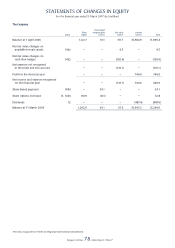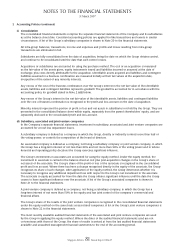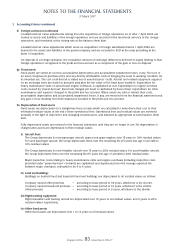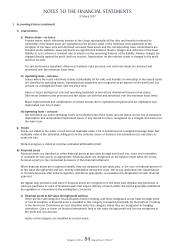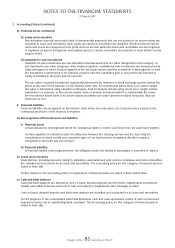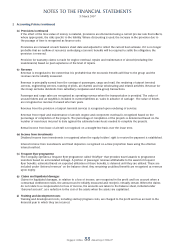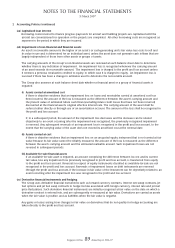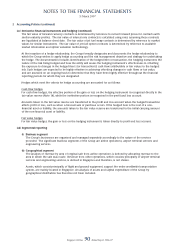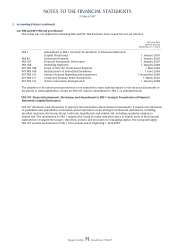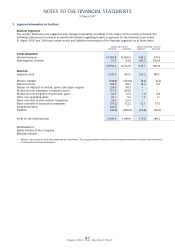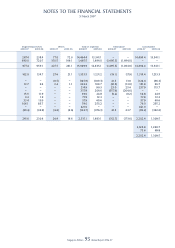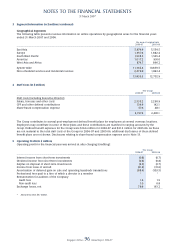Singapore Airlines 2007 Annual Report Download - page 90
Download and view the complete annual report
Please find page 90 of the 2007 Singapore Airlines annual report below. You can navigate through the pages in the report by either clicking on the pages listed below, or by using the keyword search tool below to find specific information within the annual report.Singapore Airlines 88 Annual Report 2006-07
NOTES TO THE FINANCIAL STATEMENTS
31 March 2007
2 Accounting Policies (continued)
(u) Provisions (continued)
If the effect of the time value of money is material, provisions are discounted using a current pre-tax rate that refl ects,
where appropriate, the risks specifi c to the liability. Where discounting is used, the increase in the provision due to
the passage of time is recognised as fi nance costs.
Provisions are reviewed at each balance sheet date and adjusted to refl ect the current best estimate. If it is no longer
probable that an outfl ow of resources embodying economic benefi ts will be required to settle the obligation, the
provision is reversed.
Provision for warranty claims is made for engine overhaul, repairs and maintenance of aircraft (excluding line
maintenance) based on past experience of the level of repairs.
(v) Revenue
Revenue is recognised to the extent that it is probable that the economic benefi ts will fl ow to the group and the
revenue can be reliably measured.
Revenue is principally earned from the carriage of passengers, cargo and mail, the rendering of airport terminal
services, engineering services, training of pilots, air charters and tour wholesaling and related activities. Revenue for
the Group excludes dividends from subsidiary companies and intra-group transactions.
Passenger and cargo sales are recognised as operating revenue when the transportation is provided. The value of
unused tickets and air waybills is included in current liabilities as “sales in advance of carriage”. The value of tickets
are recognised as revenue if unused after two years.
Revenue from the provision of airport terminal services is recognised upon rendering of services.
Revenue from repair and maintenance of aircraft, engine and component overhaul is recognised based on the
percentage of completion of the projects. The percentage of completion of the projects is determined based on the
number of man-hours incurred to date against the estimated man-hours needed to complete the projects.
Rental income from lease of aircraft is recognised on a straight-line basis over the lease term.
(w) Income from investments
Dividend income from investments is recognised when the equity holders’ right to receive the payment is established.
Interest income from investments and fi xed deposits is recognised on a time proportion basis using the effective
interest method.
(x) Frequent fl yer programme
The Company operates a frequent fl yer programme called “KrisFlyer” that provides travel awards to programme
members based on accumulated mileage. A portion of passenger revenue attributable to the award of frequent
fl yer benefi ts, estimated based on expected utilisation of these benefi ts, is deferred until they are utilised. These are
included under “deferred revenue” on the balance sheet. Any remaining unutilised benefi ts are recognised as revenue
upon expiry.
(y) Claims and liquidated damages
Claims for liquidated damages, in relation to a loss of income, are recognised in the profi t and loss account when a
contractual entitlement exists, the amount can be reliably measured and receipt is virtually certain. When the claims
do not relate to a compensation for loss of income, the amounts are taken to the balance sheet, included under
“deferred account”, as a reduction to the cost of the assets when the assets are capitalised.
(z) Training and development costs
Training and development costs, including start-up program costs, are charged to the profi t and loss account in the
fi nancial year in which they are incurred.


